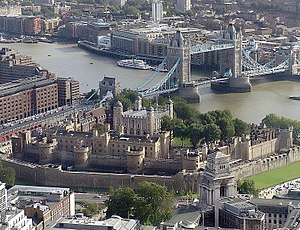
This walk is about four miles and on the flat. Allow a day for the walk as you are bound to find places of interest on the way and really should sit down and contemplate what happened in these locations and how, thankfully, times have changed.
Starting at The Tower of London
Image via Wikipedia | A view of the Tower of London which includes Tower Bridge.
Tower Bridge was used to display the heads of traitors who had been executed. The Tower of London in the suggested starting point of this walk.
Tower Bridge was used to display the heads of traitors who had been executed. The Tower of London in the suggested starting point of this walk.
Two of Henry VIII’s six wives were beheaded in the grounds of the tower and buried in non-consecrated lands.
Anne Boleyn was beheaded here in May 1536
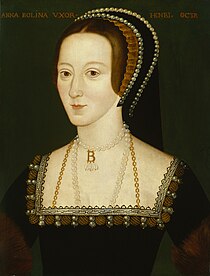
Image of Anne Boleyn via Wikipedia
Catherine Howard was beheaded here in February 1542
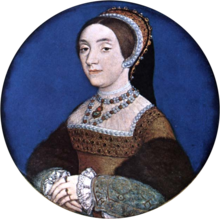
You may wish to say a prayer or have some kind thoughts for Anne and Catherine. No matter what the History books tell us and no matter what primary sources view as reasons for their executions, these were two young women who were made to put their heads on blocks and feel the blade of the executioner’s axe chop off their heads. Such actions are and never were right.
Now, lets head off to Smithfield. Consult the map or Click Here for a close up view. You should pass the Hung, Drawn and Quartered Pub if it is still trading. You could be amazed at what people think of as good taste but – as we’ll see below - executions were never sober affairs.
Our walk is now taking us up West along Great Tower Street, Eastcheap (full of banks) and then north up King William Street (full of foreign banks). We’ll not mention every place along this route but you’ll walk along Poultry and up Cheapside and be getting a good sense of London. We advise that you don’t dash but take your time and notice place names and think about their historical significance. Always take some time to look up and take in the architecture and don’t be afraid to wander down narrow alleys and have a “shufty” (a quick look). Keep an eye out for blue plaques on the side of buildings as these were placed by the Historical Society and put there to commemorate people and events – you can learn a lot in London by keeping an eye out for such clues…

Back to the business of executions. Between Cheapside and before you get to Newgate Street you’ll glimpse Saint Paul’s Cathedral. Newgate Street is in the vicinity of (as the name suggests) a gate into the city of London which was once walled. It is not far from and replaced what was Blackfriars Gate which is south as the crow flies and the London side of the river Thames. There was also a prison here which took the name Newgate.
Back to the business of executions. Between Cheapside and before you get to Newgate Street you’ll glimpse Saint Paul’s Cathedral. Newgate Street is in the vicinity of (as the name suggests) a gate into the city of London which was once walled. It is not far from and replaced what was Blackfriars Gate which is south as the crow flies and the London side of the river Thames. There was also a prison here which took the name Newgate.
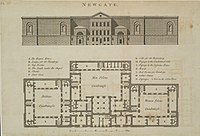
Strange but true. In its later years Newgate prison was a prison for men. However, women were burnt at the stake outside Newgate prison. Catherine Murphy was the last woman to be burnt outside Newgate prison in March 1789. This form of execution was common for women who murdered their husbands but Catherine was executed by flames for the less common crime of High Treason. Don’t imagine that her crime was anything like that of Guy Fawkes as all Catherine had done was debase coins. “Coining” was seen as High Treason because the coins that were clipped had a depiction of the king’s head on their front.
Most later public executions took place outside Newgate prison as the gallows was moved from Tyburn (you’ll pass that site later) in 1783. The last public hanging in England took place here in May 1868. The man hanged was Michael Barrett. Barrett was a Fenian and convicted of causing the Clerkenwell bombing in which 12 Londoners died in 1867. Executions took place inside the prison and in prisons elsewhere in the UK after 1868.
Next we go to Smithfield Street. You need to come off the marked route and have a nose around West Smithfield. This was where Smithfield Market was situated. (There is still a wholesale market here today). Here too was where heretics were burnt at the stake. Most of the 274 heretics burnt during Bloody Mary’s reign of terror were bunt here.
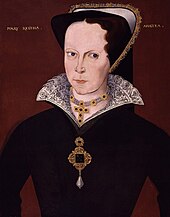
Let's take some time and think about burning people. Being burnt at the stake in England could take several hours. It could be a slow lingering death as no vital organs would be destroyed until the flames had first incinerated the lower half of the body. The slowness (like much in England) would be down to the weather. In countries where burnings took place in bright sunshine deaths would be quicker but in damp, cold England this wasn't the case.
Now our walk is going towards Speakers Corner and Marble Arch. We will be walking towards Holburn Circus on our way and passing along Great Holburn and New Oxford Street. Make your way towards Marble Arch but now you must find speakers’ corner on the outskirts of Hyde Park. Here’s the map of the area Click Here. You need to walk down Tyburn Way and cross over to the park. Why are you looking for Speakers’ Corner? Because this was the site of the Tyburn Tree. This was where the public gallows was sited and where up to 30 people could be hanged at the same time. Their dangling and struggling on the end of their nooses came to be known as the Tyburn Jig. The term “pulling my leg” came from what you did to put a hanging person out of their misery as it could take up to thirty minutes to die.

Image via Wikipedia | The Tyburn Tree
By the way, the walk to this place follows a similar route to the procession of the condemned on a cart. Behind the cart would come a troop of soldiers and behind them some dignitaries on horses. They would stop at pubs along the route and the prisoners would be given wine. They’d be drunk by the time they reached the Tyburn Tree. The map below from 1746 shows that it was near here – though difficult to distinguish exactly where – soldiers were shot. Contemplate that at the end of your walk of London execution sites.

Image via Wikipedia | Right: The site of the Tyburn Tree and where "soldiers are shot" end our walk.
No comments:
Post a Comment
Let yourself go when you comment on any issue raised by Wilma Proops or those who send Wilma letters. Wilma retains the right not to publish anything, for whatever reason. Those of you who are full of "utter crap" can stick it where the gobshite came from. Not recomended for control freaks.